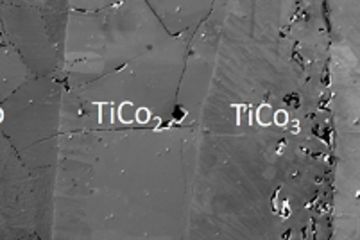All genres
2061.
Talk
Experiments and Theory of Surface- and Polycrystal Mechanics. Colloquium Lecture at the Technical University of Hamburg-Harburg, Hamburg-Harburg (2003)
2062.
Talk
Texturen und Kristallmechanik. Kolloquium, TU Darmstadt (2003)
2063.
Talk
Textures and Crystal Mechanics. Colloquium Lecture at the Materials Department at the Technical University of Darmstadt, Darmstadt (2003)
2064.
Talk
Slip system determination by rolling texture measurements around the strength peak temperature in a Fe3Al-based alloy. Intern. Conf. on Strength of Materials (ICSMA 13), Budapest, Hungary (2003)
2065.
Talk
Experimental and Theoretical Investigation of Grain Scale Plasticity. Colloquium lecture at the Department of Materials Science and Engineering of Northwestern University, Evanston, Chicago, USA (2002)
2066.
Talk
Moderne Simulationskonzepte für den Werkstoff Stahl und seine Anwendungen. VDEh Werkstoffausschuss, Düsseldorf (2002)
2067.
Talk
Computational Materials Science. Colloquium lecture at GKSS Research Center, Geesthacht, Germany (2002)
2068.
Talk
A Texture Component Crystal Plasticity Finite Element Method for Scalable Large Strain Anisotropy Simulations. ICOTOM 13, Seoul, South Korea (2002)
2069.
Talk
Theory of Orientation Gradients. ICOTOM 13, Seoul, South Korea (2002)
2070.
Talk
Modelling Applied to Aluminium Alloy Metallurgy. Keynote lecture at the 8th International Conference on Aluminium Alloys (ICAA-8), Cambridge, UK (2002)
2071.
Talk
Polycrystal Mechanics. Colloquium at the National Institute for Standards and Technology NIST, Washington, D.C., USA (2002)
2072.
Talk
Simulation of Recrystallization. Colloquium lecture at Wright Patterson Research Center, Dayton, Ohio (2002)
2073.
Talk
Polykristallplastizität. Kolloquium an der Fakultät für Werkstoffwissenschaften der Universität Erlangen-Nürnberg (2002)
2074.
Talk
Texture-Components in Plasticity Simulations. ICAA8, Cambridge, UK (2002)
2075.
Conference Report
Role of Simulations and Experiments in Analytical Field Ion Microscopy. Microscopy and Microanalysis 29 (Supplement_1), p. 602 (2023)
2076.
Poster
Thermoelectric Materials: A methodology for defects characterizaton. Understanding Transport Processes on the Nanoscale for Energy Harvesting Devices Seminar, Physikzentrum Bad Honnef, Bad Honnef, Germany (2021)
2077.
Poster
Machine-learning-assisted revealing L12 ordered structures in FCC-based alloys. BIGmax workshop 2020, online, Düsseldorf, Germany (2020)
2078.
Poster
Phase Transformation of Copper Hexacyanoferrate Cathode in Aqueous Zn-Ion Battery. 2019 MRS Fall Meeting , Boston, MA, USA (2019)
2079.
Poster
The surface structure of AgCu catalysts in ethylene epoxidation. Tenth Joint BER II and BESSY II User Meeting, Helmholtz Zentrum Berlin, Berlin, Germany (2019)
2080.
Poster
Thermoelectric Materials: a methodology for defects – properties correlation. International Workshop on Advanced and In-situ Microscopies of Functional Nanomaterials and Devices, IAMNano, Düsseldorf, Germany (2019)











